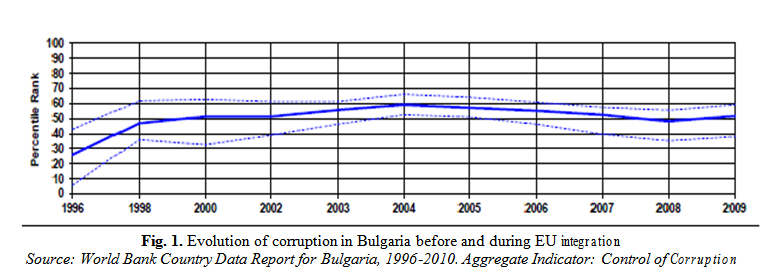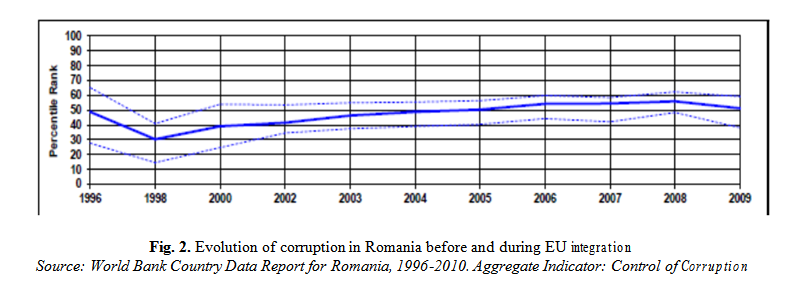Evaluation of corruption in Romania and Bulgaria before joining the European Union

Abstract
Corruption is seen as an important problem in post-communist countries compared to Western states. Communist organizations were based on corruption, acting as a united force in a state where kleptocracy was creating the norm. As the “europeanization” began, all countries from Eastern Europe have risen up a really sensitive subject which they were dealing with. More accurately, high levels of corruption have proven to be demanding factors that have really influenced the condition of the last two countries to be integrated in the European Union: Romania and Bulgaria. This article states that little the pressure is from the European Union, the higher the levels of corruption will be, being defined as the exploatation of public service for private achievement. It will also show the relation between European leverage and the situation of corruption in Romania and Bulgaria, since the mid ‘90s, when the applications for European Union enrollment were submitted by these two countries.
Table of Contents:
1. Introduction
2. Corruption in Bulgaria and Romania: Findings, literature and sayings
3. Data results before EU accession in Bulgaria
4. Data results before EU accession in Romania
5. Changes established by the EU anti corruption policy
6. Discussions
7. Conclusions
1. Introduction
Corruption created new dimensions in all levels of modern society, reaching fresh heights, and, in the meantime, opening new challenges. In many developing countries, corruption has had a significant concussion on the process which is defining the most important rules, in order to manage their economies and societies, encoding their interests for limited advantages and impeding political and socio-economical improvement.
Most of well-known corruption scandals have exposed politicians, via media news usually, in abusing their status to transfer public assets ither to themselves or their partners, through private stakes, using complex networks of private and/or public organizations. In many countries, the general population recognizes the interlink between corruption and the main institutional framework, as the main cause of undermining governance and decreasing the integrity of their states [1].
In the early ‘90s, new opportunities appeared for the European Union and unchained a lot of intentions in motion, starting with the slightly drop of communism which appeared in most of the Eastern European countries. The “Europeanization East” had been described by Schimmelfennig as being a process of the EU rule adoption [2].
Meanwhile, the preparation of favourable conditions especially for central and eastern countries easily became one of the European Union’s main priorities, during the next period. After the fall of communism, the relations which started to be created between the “Western world” and the freshly founded eastern states changed radically, both parts seeking for cooperation and development in all fields (economic, political and cultural), creating appropriate conditions for an expected common and greater future connections.
“The prospect of Union enlargement to take in ten countries of central and eastern Europe” [3], which included Romania and also Bulgaria was defined, for the first time, in the well- known.
Agenda 2000, as one of the first official paper which exposed the status of the eastern states. Because of these circumstances, Western Europe started a process designed to help its Eastern neighbours to accept and implement a set of standards generally used in the industrialized countries, for the basis of a new commencement defined by different values.
Countries from Eastern Europe raised a very delicate issue to deal with, in what concerns the Europeanization, like high levels of corruption among its concerning aspects [4], especially for the last two countries which have been accepted in the European Union: Bulgaria and Romania.
I have decided to study these specific countries, Romania and Bulgaria and not other ones because of the multiple similarities which exist between them:
1) both states had recognized their serious corruption level and its side effects, most of them present in the law system, starting with the late 90s;
2) in these two countries, it is a strong connection between the economic basis and the political structure, which have mostly influenced corruption;
3) a lot of different paths had been localized by the European Union for Bulgaria and Romania, in order to maintain and, of course, gain their individual membership. In conlusion, starting the beginning, the progress of two countries was some how interlinqued as they had been programmed to join the European Union together on the same date: 1st of January 2007.
2. Corruption in Bulgaria and Romania: Findings, literature and sayings
Since the collapse of commăunism, the status of corruption of the ex-communist East- European states has been a matter of controvers discussions. Concerning Bulgaria and Romania, at the end of the 1990’s corruption has been publicly exposed, with the help of the mass-media [5]. European organizations provided qualified help for the two states in the struggle for reducing corruption and consolidate democracy, while aiming for a solid expansion of the European Union in the eastern european countries.
Most of the national studies, have been published but it seems that the levels of corruption in these two countries, have not been evaluated in comparison by them, in the period before, as well as after europeanization.
The analysis of corruption which exists in Bulgaria and Romania has not been so deeply studied, concerning the interval of time before their accesion. Speaking in a more subjective opinion, the lack of studies is framing this article as being more interesting to the public.
In my opinion, authors like Sedelmeier and Schimmelfennig (2005), came up with one of the best theories, in which the procedure of Europeanization is perfectly explained as well as the acceptance of the european rules followed by the eastern states. The concept of “goodness of fit” used in their work, “The Europeanization of Central and Eastern Europe”, has been created to analyze the consequences regarding the tension created between national and European background, the UE guidelines implementation, but also trying to propose the key solutions to make the adoption of this rules easier for national governments. Corruption is not precisely defined by thesef two great authors, as they try to create a general framework to be applied to variable issues found in countries with minority protection, like Romania, Hungary and Poland.
Other authors which studied corruption in Romania, Precupetu & Preoteasa (2008), between the period of the years 2001 and 2007, also analyzed the pre-accession process. They focused on several domestic subfields, like: economy, politics, civil society, media and justice. Their work is important for the theme of this article because it analyzes the levels of corruption right before 2007, the pre-accession period. Romanian authors are offering an internal perspective over national obstacles, with highlights on uncertain measures which have been built, as well as on the expansion of the anti-corruption phenomena [6]. I consider this is a valuable research regarding the public perception of corruption in Romania, along with the attempt to offer several solutions for consolidating democracy and reducing corruption.
Smilov & Dorosiev (2008) made the analysis of bulgarian corruption from a different angle by studying various aspects, starting from social and cultural ones. While they examine the inexplicable accept of corruption at an “everyday level”, they are also using a subjective approach and suggesting recommendations to sustain the fight against the corrupt behavior.
Their methodology, even if it is similar to the one used by romanin authors, it had been based on two different analytical models, political and cultural, in order to create a holystic picture regarding perception of corruption in the Bulgarian society. Smilov & Dorosiev defined corruption through their specific pattern, insisting on different traces: legal and cultural ones.
The emphasis and the effects of the pre-accession policy in fighting corruption and diminish it in the post-communist countries from the Eastern-Europe, like Romania and Bulgaria are very well analyzed in the article written by Vachudova. From a different point of view, same countries and identical issues concerning corruption, had been examined by Svetlozarț’s work, but for the post-accession period. These two studies offer many insights, which had been combined in my article in order to describe corruption from the two neighboured countries, trying analyze the problem as close to reality as possible.
In order to deeply analyze changes that exist in different levels of corruption in Bulgaria and Romania, a cross-country research had been realized from the beginning of 1999 and 2007. The final goal was to understand how corruption had been shaped by the Europeanization process in these countries [7]. There had been analyzed three periods of time, representing important moments in the evolution of romanian and bulgarian “europeanization”. I have studied first the mid ‘90s, after evaluating existing data about corruption, when both of the states submitted applications for the European Union enrollment and also when first of the international reports had been broadcasted. The second interesting part is given by the year of 2004, when the Accession Treaty had been signed by both disscussed countries. The third, final highlight is given by the day of 1st of January 2007, a turning point in the fight against corruption, when full membership was obtained.
Studying the existing data will help to understand if the process of Europeanization has had a good effect in the fight against national corruption. With the use of frameworks created by Sedelmeier and Schimmelfennig, as well as Gray’s and Sandholtz, a demonstration will be made about how high the normative and economic European pressure is, and the potential effect on lowering levels of corrupt proceedings in Bulgaria and Romania.
3. Data results before EU accession in Bulgaria
In order to understand better about how corruption has changed since the year of 1996 until 2009, I have decided to use a data set realised by the World Bank which and observe different fluctuations occuring during that interval of time in Bulgaria and Romania and also measures corruption from the internal point of view.
I have chosen the following reports, issued by the World Bank, because of the long-time span that they cover. They are highlighting the evolution of the Corruption Control indicator made for Bulgaria and Romania starting from 1996 to 2009, as presented in Fig. 1.

Regarding Bulgaria, it can be noticed the fact that corruption levels have gone higher and higher until 2004 and, after that, it slightly regressed or remained unchanged until 2007.
According to the information above, the process of integration did not have the expected impact, but maintained corruption at a relatively tolerable level. After the period of accession, the indicator of corruption expressed parts of deterioration, mainly as a result of the fact that the initial public and institutional interest (i.e., the European Union integration) was progressively gone [8].
4. Data results before EU accession in Romania
Analyzing the Country Data Report made for Romania, it can be observed a slower, but constant evolution in time. Since 1996, Romania registered a moderate but continuous progress until 2007, when the European Union integration process took place (see Fig. 2).
Sandholtz’s theory about international integration can be assiciated with the evolution seen in the chart under, and the importance of encouragement in the pre-accession process, as part of the efficient strategy.

Once the incentives and also the pre-integration programs are finished, the most interesting observation is that 1 year right after our country accession (interval 2008-2009), the romanian index starts to regress, while Bulgaria’s scorings are showing a real progress. The ups and downs of Romania’s path are presented in the chart above, along with the attempt to control the corruption indicator, before and after the European Union integration [9].
5. Changes established by the EU anti corruption policy
These two charts are giving a brief description regarding the levels of corruption both in Romania and Bulgaria, so the establishment of the causes that determined the changes and the special evolution in time, are the next steps to be done. The conclusions obtained from these investigations has shown that these countries tried to become more transparent, but the tendency was lost in evolution, especially during the process of pre-accession.
The conditions and formality of EU rules are clearly understood as they facilitate the acceptance and success for the implementation. A greater degree of transparency in implementing and creating anti-corruption environment, as well as accessing European funds, imposed serial conditions needed to be accomplished by Bulgaria and Romania in order to obtain their membership status. The Acquis Communautaire had to be implemented and adopted by both countries, along with the recommendation to step up the fight against existing corrupt practices [10].
The integrating process of the membership agreement conditions forced the governments of Bulgaria and Romania to form new and more efficient policies against corruption. In the same time, this forced the European Union to honor the contract and offer the promissed benefit: full membership and european funding and support [11]. These factors were acting bidirectional and represented the basis of successful conditions, based on credibility and clarity.
6. Discussions
The constraint of this article is linked to the concept that corruption cannot be measured.
Firstly, one could see corruption as a real “Pandora’s box”, while trying to identify and measure this extreme phenomenon. Secondly, the international datasets which exist do not objectively quantify corruption, but mainly the perception of corruption as a national, particular status. Even if these international “tools” used in measuring corruption are oftenly appreciated and generally accepted by scientists because of their parallel approach, they do not offer the special, national insights, dealing with corruption in real life.
The selection of these two specific balcanic countries in my short analysis, Romania and Bulgaria, had several reasons, but the main was the fact that these are the only states that acceded EU in the beggining of the year 2007 and dealing with identical corruption problems or comprised “solutions” in the pre-integration program [12]. The results of this research present an overview on consequences of Europeanization process, that has modified in Romania and Bulgaria the levels of corruption since 1995, when the applications for EU membership were submitted, and up to the year 2007 [13]. Special attention should be given on the financial rewards and European pattern, proved as powerful tools in the fight against corruption.
7. Conclusions
The process of post-accession to the EU did not reach to the predicted results at least concerning the struggle against corruption after the accession, once it we realised that the fight against corruption began to stand in the same position as in pre-accession period. The process of Europeanization, taken just for the pre-2007 period, led only to the stagnation of corrupt practices. Considering the improvement of the post-accession process, it is obvious that, in order to be more successful, the program needs some fresh encouragement which can successfully restore the lost one, disappeared after accession [14].
This strategy will recover the power of the European Union leverage and will lead to an increasing fight concerning national corruption. Despite the fact that the levels of corruption remained quite high in both east european countries, the pre-accession procedure obviously led to a positive progress in the corruption status in Romania and Bulgaria, which can maintain hope for reaching in the future to a generally accepted European medium-level.
Contributo selezionato da Filodiritto tra quelli pubblicati nei Proceedings “International E-Conference Enterprises in the Global Economy - 2018”
Per acquistare i Proceedings clicca qui.
Contribution selected by Filodiritto among those published in the Proceedings “International E-Conference Enterprises in the Global Economy - 2018”
To buy the Proceedings click here.



